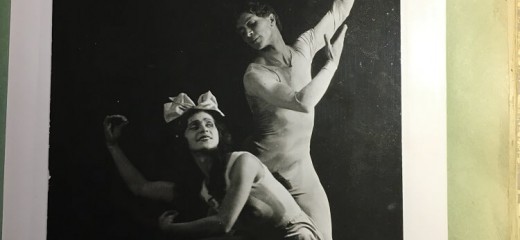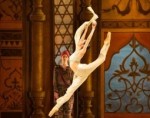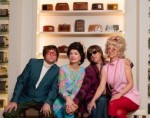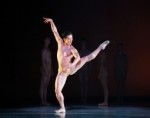
The Folk in French Neoclassicism
by Colin Murray
What does it mean for ballet to be “neoclassical”? What is neoclassical ballet’s relationship to classicism, to modernism, to society, and to politics? Mark Franko engaged with these questions as they arose in interwar France in his talk at Temple University’s Dance Studies Colloquium, “Parade as a Critical Concept in French Interwar Dance Theory.”*
The jellyfish, the cockerel, and harlequin are three images Franko invited us to contemplate as he presented material from his forthcoming book, The Fascist Turn in the Dance of Serge Lifar: Interwar French Ballet and the German Occupation (Oxford University Press), which examines Lifar’s dance aesthetics and politics, and the construction of balletic neoclassicism in early twentieth-century France. In this colloquium, Franko focused on the work of three of Lifar’s contemporaries—literary theorists Jean Cocteau and Paul Valéry, and anthropologist André Varagnac—drawn together for their critical engagement with popular culture. These figures, Franko argued, articulated theories of balletic neoclassicism that took the popular (as manifested in the concept of "parade"**) to be a fundamental element of modern ballet. In so doing, they contributed to what Franko treats as an emerging, cross-disciplinary discourse on dance in this period, and positioned themselves in counterpoint to the more formalist Russian-émigré theorists such as André Levinson.
The notion of parade is particularly apparent in the 1917 ballet of the same name, a collaboration between Léonide Massine, Erik Satie, Pablo Picasso and Cocteau, which features a series of fairground performers enticing the audience to view a music hall show that ultimately is not performed. As Franko demonstrated, Cocteau’s use of parade in his formulation of neoclassicism as a modernist project is an integral part of the latter’s work. Controversially rereading Cocteau as an unorthodox neoclassicist, Franko highlighted the importance of popular culture in Cocteau’s writing, in which the codified steps of classical ballet come to be “retheatricalized” through the incorporation of un-codified gesture both personal to the performer and inspired by vernacular practices. The cock and the harlequin mentioned above, invoked by Cocteau himself in one of his writings, figured in this discussion as references to regionalism and international art production, respectively.
Franko moved on to Valéry, whose influential yet admittedly perplexing theorizations of the energetics of dance at this time nonetheless aligned him with Cocteau. In Valéry’s writing, the jellyfish alluded to earlier, suspended and expanding in water, becomes an illustration of the dancer’s ability to both create and consume its own energy in fluid movement, unconstrained by preconceived shapes or lines of extension (such as those motivating the basic positions in classical technique). Valéry was little concerned with composition or choreography, favoring the spontaneous execution of movement—the “act” of creation—as the essential element of dance.
Franko concluded with a short discussion of Varagnac, an anthropologist whom Franko understands to have treated folklore in a modernist way, as a practice that continually produces itself and creates its own traditions (rather than relying on what might be termed “official” tradition). Varagnac’s views on folklore thus integrate concepts of self-procreation and the vernacular from Valéry and Cocteau, respectively.
I have mentioned Franko’s references to the clown, the jellyfish, and the cockerel not because they were the central focus of the talk but because, for me, they emblematize the intriguing influences popular culture had on early constructions of the “neoclassical” in ballet. In this vein, the image Franko displayed of Lifar in George Balanchine’s Apollon musagète—Lifar, gazing downward, in a crimson tunic with Greek-style laces up to his knees, while he and the three muses stand in the sixth position he is known for having established—was impressive. As situated in Franko’s discussion, the image underscored the radical differences between the aesthetics of the neoclassical from the interwar period in France and the neoclassical prevalent on the American stage today. As an instance of the latter, one might visualize Pennsylvania Ballet’s productions of Apollo in recent decades and the now-iconic image of the ballet’s concluding pose. At the same time, the photograph pointed to the political dimension of the construction of neoclassicism haunting Franko’s discussion. As Franko mentioned as a preface, he views early twentieth-century French neoclassicism as a cultural wound resulting from Franco-German enmity, deeply steeped in nationalist and modernist principles, tied up with the rise of fascism in the interwar years, and crucial for understanding the later baroque turn in postmodern choreography. These issues are explored in his forthcoming book which, if the Colloquium talk is any indication, promises to be extremely rich and provocative.
*Franko is the director of the Institute of Dance Scholarship at Temple, which sponsors the Colloquium series, and I assist him in its management. I also work closely with him as an advisee for my dissertation as a Ph.D. candidate in the Dance Department at Temple.
**Franko explained parade (French) as a fairground practice in which a dancer performs outside the compositional framework of a given piece.
Homepage image was taken by Mark Franko of a set model for the premiere of Parade exhibited at the Centre Pompidou, Paris. The story-page image was taken by Franko of a photograph by Victor du Bont (Fonds Kochno at the Bibliothèque-Musée de l’Opéra National de Paris), featuring original cast members (Lydia Lopukhova and Nicolas Zverev) playing the acrobats in Parade.
Mark Franko, “Parade as a Critical Concept in French Interwar Dance Theory,” Temple University Dance Studies Colloquium, January 21.
By Colin Murray
February 6, 2020










